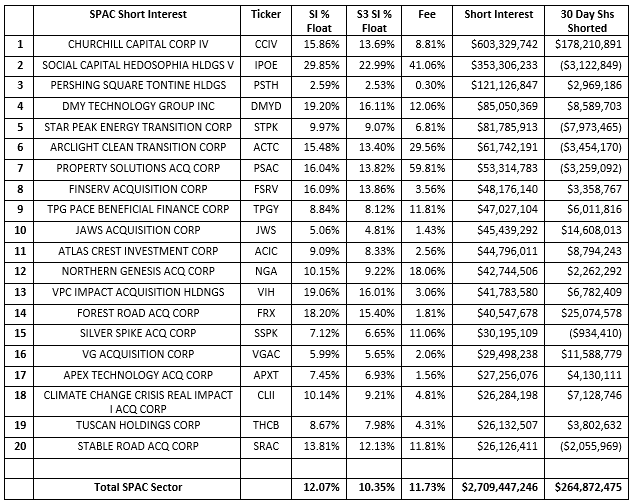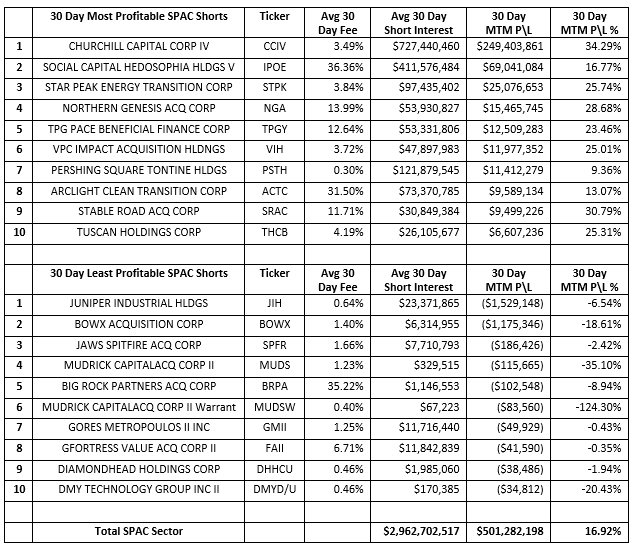We follow 885 SPACs (equities and warrants) that have short interest on our Blacklight SaaS Platform and Black App. We are seeing active short selling in the sector as stock prices in the sector decline. Over the last 30 days the IPOX SPAC Index is down -6.55%, the SPAC ETF is down -19.18%, the SPCX ETF is down -1.31% and the SPXZ ETF is -21.84% (the return variance is due to the different mix of pre- and post-merger SPACs in each portfolio). In response to these declines SPAC short sellers have sold short an additional $265 million of SPAC shares over the last 30 days.

Short interest in the SPAC sector has decreased from $2.904 billion to $2.709 billion over the last 30 days. This -$195 million decrease consisted of a -$460 million change in market value due to stock price declines offset by +$265 million of new short selling. As the value of their short SPAC holdings were decreasing, short sellers were generating mark-to-market profits and continuing to sell into the price weakness and increasing their short positions.
SPAC short sellers were up +$501 million, +16.92%, in net-of-financing mark-to-market profits over the last 30 days. The sector wide weakness made most SPAC shorts profitable with only 28% of the securities in our SPAC population producing red (unprofitable) numbers. The two most profitable shorts were also the two most shorted SPACs as CCIV and IPOE topped both lists.

While some of this short activity can be related to hedging activity against pipes or warrants most of the shorting is more technical in nature, especially since there are no company fundamentals to analyze. It looks like short sellers are looking for price pullbacks in SPACs that have had large recent or historical price moves.
Another fly in the ointment for the SPAC sector are new regulatory proposals by the Securities and Exchange Commission. The SEC has recently issued new accounting guidance concerning the warrants issued by SPACs which may ultimately not be considered equity instruments but rather liabilities. These warrants, which are usually issued to early investors and SPAC sponsors\management, would need to be marked-to-market, and would affect the quarterly financial reporting of existing SPACs. The uncertainty of the SPAC regulatory landscape has proved to be a headwind for both existing and new SPAC issuances.
Looking at short selling trends over time provides insight into overall market sentiment as well as the strength of bearish conviction in individual equities. Our Blacklight SaaS platform and Black APP provides an up to date view of short selling and short covering on an equity, sector, index, or country-wide basis allowing investors\traders to better manage their existing long and short positions.
Research Note written by Ihor Dusaniwsky, Managing Director of Predictive Analytics, S3 Partners, LLC
For deeper insight into short side data and analysis contact me at Ihor.Dusaniwsky@S3Partners.com
Click for 10 Day Complimentary Access to Bloomberg/S3 Black App Pro
The information herein (some of which has been obtained from third party sources without verification) is believed by S3 Partners, LLC (“S3 Partners”) to be reliable and accurate. Neither S3 Partners nor any of its affiliates makes any representation as to the accuracy or completeness of the information herein or accepts liability arising from its use. Prior to making any decisions based on the information herein, you should determine, without reliance upon S3 Partners, the economic risks, and merits, as well as the legal, tax, accounting, and investment consequences, of such decisions.